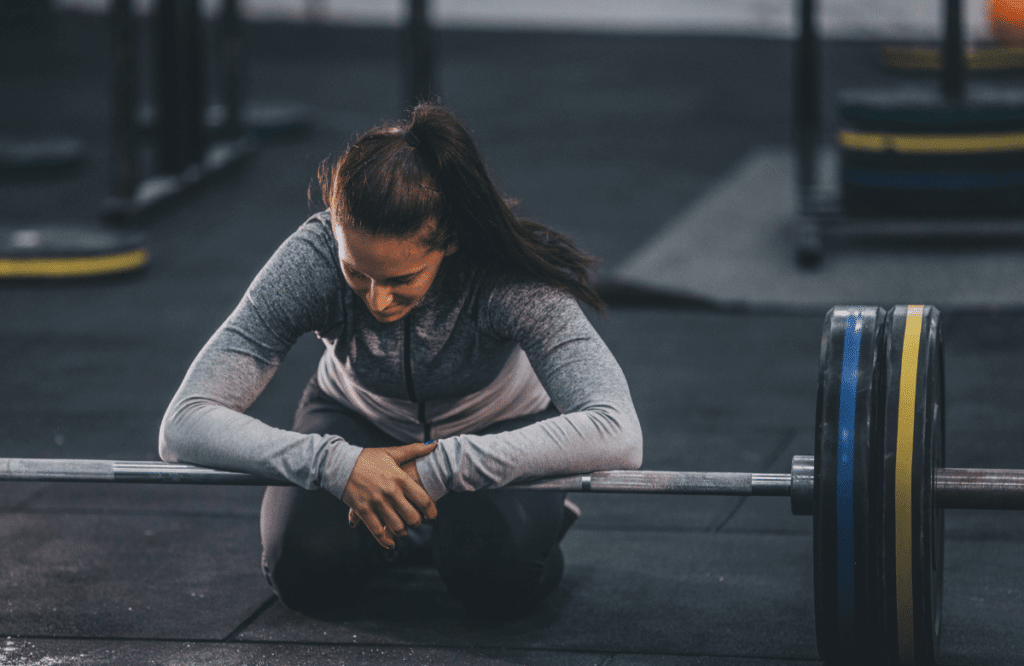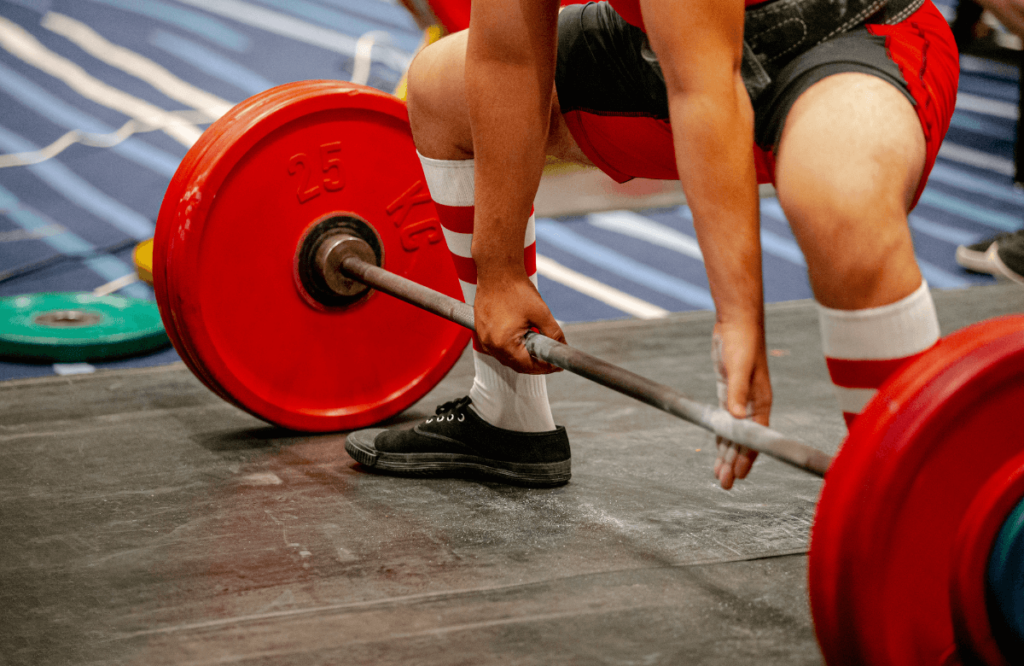Deadlifts have long been a subject of debate when it comes to their safety. Some people believe that heavy deadlifts are dangerous, and they’re not worth taking a risk on.
Others disagree.
I don’t believe deadlifts are dangerous. I’ve coached people on how to perform deadlift variations for 20 years. I can see that when performed badly, deadlifts could be seen as dangerous, but with effective coaching, good technique and an appropriate spinal loading, deadlifts are a fantastic functional exercise.
So, whilst some argue that deadlifts pose a significant risk of injury, others tout their numerous benefits.
In this article, we will delve into the science behind deadlifts to determine whether they are truly dangerous or if the concerns are overblown….
Jump to:
- What are Deadlifts?
- Why do deadlifts have a bad reputation for injuries?
- How do people injure themselves when deadlifting?
- What are the most common deadlift injuries?
- Can deadlift injuries be prevented?
- Tips to make deadlifting safer…
- What does the court rule – are deadlifts dangerous?
- Deadlifting – further reading
What are Deadlifts?
Before we delve into the safety aspects, let’s understand what deadlifts are. Deadlifts are a compound exercise that targets the muscles in the lower body, including the glutes, hamstrings, and quadriceps.
They also engage the core, back, and upper body muscles to maintain stability and control during the movement.
Why do deadlifts have a bad reputation for injuries?
Deadlifts have gained a bad reputation due to anecdotal evidence of injuries occurring during the exercise.
The perception of danger surrounding deadlifts can also be attributed to improper form, lack of proper warm-up, and attempting weights beyond one’s capacity. If you have an injury history that includes lower back issues, they may well be best avoided.
By their very nature, deadlifts require the lower back to engage and assist in lifting heavy weights. For people with previous lumbar spine injuries and weak lower back muscles, the compressive load can aggravate the area.
To say they’re dangerous across the board though is unfair. They’re dangerous for some people in some circumstances, but they’re also a great way to train the entire body in a single movement.

How do people injure themselves when deadlifting?
Injuries during deadlifts often occur when individuals fail to maintain proper form or when they push their limits too far without building strength. Some common mistakes include rounding the back, lifting with a jerking motion, or not engaging the core muscles.
Here’s a list of the common injury risk factors with deadlifts…
- Lifting with poor form. This is the most common cause of deadlift injuries. When the form is poor, the lower back is put under a lot of stress, which can lead to injury. Keeping your core tight helps to protect this area.
- Lifting too much weight. This is another common cause of deadlift injuries. When you lift more weight than you are capable of, you increase the risk of injury, especially to the lower back. Deadlifts are a great way to lift a heavier weight than usual, but only if you’re safe.
- Rounding the back. This is a common mistake that people make when deadlifting. When the back is rounded, it puts a lot of strain on the spine, which can lead to injury. This is less dangerous for the lumbar spine, but more impactful on the upper back.
- No controlling the descent. This is another common mistake that people make when deadlifting. When you lower the weight too quickly, you lose control of the load and it can cause a back injury. Control the weight up and down. One exception is if you’re lifting with bumper plates – you can let go of the bar then and drop the weight.
What are the most common deadlift injuries?
While any exercise carries some risk of injury, the most common injuries associated with deadlifts include strained muscles, herniated discs, and lower back pain caused by muscle spasm. These injuries are often the result of overloading the spine or using incorrect form.
- Lower back pain. This is the most common deadlift injury. It can be caused by lifting with poor form, lifting too much weight, or rounding the back. This is usually muscular in nature, and causes the muscles in the lower back to spasm. It usually lasts a few days.
- Hamstring strains. Hamstring strains can be caused by lifting with poor form or lifting too much weight. It’s more common when performing one of the deadlift variations, such as stiff leg deadlifts or Romanian deadlifts. Depending on severity, they last a few days to a few weeks.
- Quadriceps strains. Quadriceps strains can be caused by lifting with poor form or lifting too much weight. This is more common with low handle trap bar deadlifts, but even then they’re not that frequent. Depending on severity, they last a few days to a few weeks.
- Lumbar disc herniation. A lumbar disc herniation is a serious injury that can occur when the disc between two vertebrae in the lower back ruptures. This can cause pain, numbness, and weakness in the lower back and legs. This is the most serious deadlift injury, often needing surgery to be repaired. It’s important to say these are VERY rare.
The reality is that serious injuries from deadlifting in training sessions are very rare. A well balanced training program, appropriate spinal loading and good coaching minimizes deadlift risks. You can never entirely prevent injury from deadlifts, but that’s the same for all exercises.

Can deadlift injuries be prevented?
Yes, deadlift injuries can be minimized and even prevented by following some important guidelines. Practicing proper form, gradually increasing weights, incorporating appropriate warm-up exercises, and listening to your body’s limitations are crucial steps in injury prevention.
There are a few things you can do to reduce your risk of injury, including:
- Learn proper deadlift form. This is the most important thing you can do to prevent deadlift injuries. There are many resources available online and in gyms that can teach you proper deadlift form. Hire a coach, watch videos etc.
- Start with a light weight. Don’t try to lift too much weight too soon. Start with a light weight and only increase the weight as you get stronger. Build up the required muscular strength before pushing yourself.
- Listen to your body. If you feel pain, stop the lift. Don’t try to push through the pain. An ounce of prevention is worth a pound of cure.
- Warm up properly. Warming up before you deadlift will help to prepare your body for the lift and reduce your risk of injury. Don’t go into heavy loading without a proper warm up.
- Give yourself enough recovery time. Rest is important – whether that’s between workouts (giving you enough days to recover), or between sets (resting enough so that you’re not too tired when you lift). A fatigued lifter is a dangerous lifter – that’s when mistakes creep in.
Do lifting belts help make deadlifting safer?
Lifting belts are often used to provide support and stability during heavy lifting exercises. While they can help maintain intra-abdominal pressure and potentially reduce the risk of injury, it’s important to note that belts should not be solely relied upon. Developing core strength and utilizing proper form are more important for long-term safety.
In a 2022 study titled ‘The influence of weightlifting belts and wrist straps on deadlift kinematics, time to complete a deadlift and rating of perceived exertion in male recreational weightlifters’, study authors reported that…
Weightlifting belts and wrist straps, when using together, have positive effects on the kinematics of deadlift. Trainers should recommend the use of a belt and straps together, but not straps alone, to recreational weightlifters when performing deadlift training.
So the research suggests that when performing heavy deadlifts, using belts and straps can help. It still doesn’t negate the need to learn decent deadlift form though.

Are certain types of deadlift more dangerous?
Different variations of deadlifts, such as conventional deadlifts, sumo deadlifts, and Romanian deadlifts sequence muscles differently.
However, there is no scientific evidence to suggest that any particular type of deadlift is inherently more dangerous than others. The key lies in performing them with proper form and within your individual capabilities.
In fact, there’s evidence that deadlifting can actually help to treat certain forms of lower back injury. In a 2012 study titled ‘Treating persistent low back pain with deadlift training – A single subject experimental design with a 15-month follow-up’, the researchers concluded…
As a result of this pilot study, the authors hypothesize that deadlift training may be a successful treatment for subjects with lower back pain of discogenic origin.
The research showed that it wouldn’t help lower back pain caused by arthritic changes, but it shows it has useful clinical applications for some conditions. This is a major revelation, because many people shy away from deadlifting because of their lower back issues.
Before embarking on a program, speak to a medical professional and see if deadlifting could work for you.
Best warm up for deadlifts?
An effective warm-up is crucial for preparing the body for the demands of deadlifts. It should include dynamic stretching exercises to increase blood flow, mobility exercises to loosen up the hips and hamstrings, and activation exercises to engage the core and glute muscles.

Tips to make deadlifting safer…
Here’s a few basic tips to help prepare your body for barbell deadlifts…
Use an appropriate warm up
Never skip your warm-up routine, as it helps prepare your muscles and joints for the exercise. Start with gentle cardio to help improve the circulation and make the tissues more elastic.
From there, we need to perform movements that mimic the deadlift. My personal favorite is a kettlebell swing, because it engages the same muscles and it’s an effective hip hinge movement. Start light, then build up. A couple of sets of 15 with a medium weight is sufficient.
Finally, perform sets of deadlifts with an empty bar, then a very light weight, a medium weight, then your working weight.
Get into a good set up position
Focus on maintaining a neutral spine, engage the core, and keep your shoulders back before initiating the lift.
The hips should be low, the chest should be up and the hands maintaining a good grip on the barbell. Take the ‘slack’ out of the bar by lifting just enough so that the bar is ready to break ground when you start your initial leg drive.
Break the movement down
Dividing the deadlift into smaller movements can help reinforce proper form and reduce the risk of injury.
To simplify the deadlift, I use these basic exercise mechanics for my clients to visualize the movement pattern. By breaking down a lift into the following sections, they find it easier to perform…
1. Leg press
2. Hip thrust
3. Hips back
4. Negative squat
The other coaching points (neutral spine, core tight, shoulders over the bar at the start etc) are my job to cue during the lift.
Re-Set with each rep
Avoid performing consecutive reps without resetting your starting position, as this can compromise form and increase the risk of injury.
Forcing a reset of your position prevents you rushing your reps, which can increase your injury risk.
What does the court rule – are deadlifts dangerous?
Any exercise can be dangerous if performed incorrectly.
In powerlifting (a sport where lifters perform squats, bench presses and deadlifts), a ‘Narrative review of injuries in powerlifting with special reference to their association to the squat, bench press and deadlift’ showed that most studies reported bench press injuries, with pectoralis major ruptures being the most frequently reported specific injury.
So they’re theoretically less dangerous than more popular exercises!
The other point to raise is that deadlift risks have the same origin as other exercises – lifting with poor form, lifting too heavy, not warming up properly etc. These are risk factors across the board, and are not specific to deadlifts.
We’ve also shown that there’s evidence in support of clinical use of deadlifting. If an exercise can be used therapeutically, it can’t be all bad!
The conclusions to draw here are that you absolutely benefit from deadlift training. The aspects of deadlifts that are dangerous can be largely negated with good programming and effective execution of the movement.
Deadlifting is no more dangerous than many other exercises, and the benefits of deadlifting far outweigh the risks.
Deadlifting – further reading
For those interested in further exploring the topic of deadlifts and their safety, there are numerous resources available on our website. Take a look at some of our deadlifting content here.














